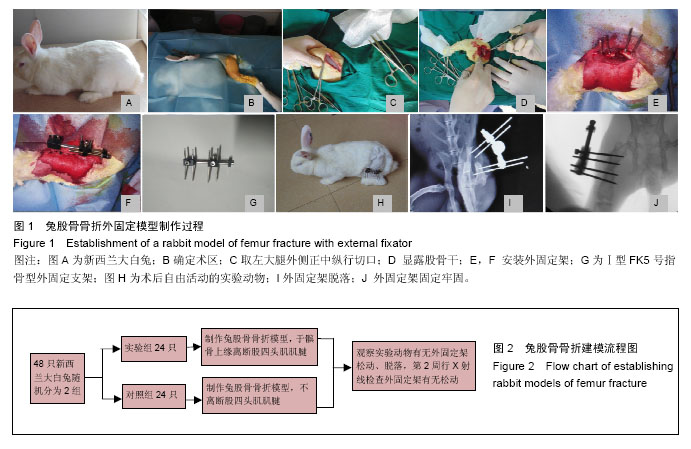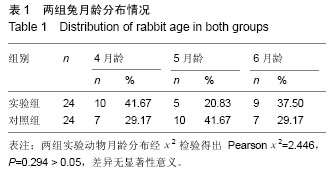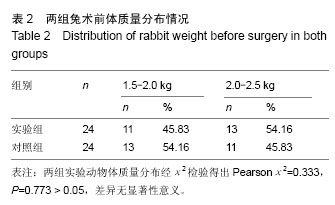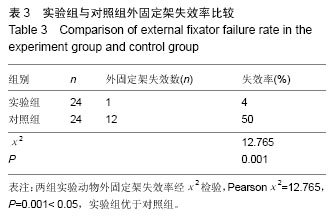| [1] Nehrbass D,Arens D,Zeiter S.Spontaneous bilateral avulsion fracture of the tuberositas tibiae in a New Zealand White rabbit-A counterpart to Osgood-Schlatter disease in humans?. Exp Toxicol Pathol. 2015;67(2):223-227.
[2] Cao Z,Jiang D, Yan L,et al.In vitro and in vivo osteogenic activity of the novel vancomycin-loaded bone-like hydroxyapatite/poly (amino acid) scaffold.J Biomater Appl.2016;30(10):1566-1577.
[3] Halanski MA, Yildirim T, Chaudhary R, et al.Periosteal Fiber Transection During Periosteal Procedures Is Crucial to Accelerate Growth in the Rabbit Model. ClinOrthopRelat Res.2016;474(4):1028-1037.
[4] Friel NA, McNickle AG, DeFranco MJ, et al. Effect of highly purified capsaicin on articular cartilage and rotator cuff tendon healing: An in vivo rabbit study. J Orthop Res. 2015;33(12):1854-1860.
[5] Takahashi M, Noda M, Saegusa Y.A new treatment for avulsion fracture of the calcaneus using an Ilizarov external fixator. Injury.2013;44(11): 1640-1643.
[6] Bumbasirevic M, Atkinson HD, LesicA.Ilizarov treatment of scaphoid nonunion. Injury.2013;44(3): 346-350.
[7] Popkov A, Aranovich A, Popkov D.Prevention of recurrence of tibia and ankle deformities after bone lengthening in children with type II fibular hemimelia. Int Orthop. 2015;39(7):1365-1370.
[8] Elmadag M, Uzer G, Yildiz F, et al.Comparison of four different techniques for performing an osteotomy a biomechanical, radiological and histological study on rabbits tibias.Bone Joint J.2015;97-B(12):1628-1633.
[9] Qu H,Knabe C,Radin S, et al.Percutaneous External Fixator Pins with Bactericidal Micron-Thin Sol-Gel Films for the Prevention of Pin Tract Infection. Biomaterials. 2015;62:95-105.
[10] Ostrum RF, Litsky AS, Anson LW. Limited internal fixation of the tibia with external fixation: an in vivo canine study. J Orthop Trauma. 1994; 8(1): 50-53.
[11] Schumacher M,NeumannS.Clinical use of the U-shaped external fixator with enhanced threadplate (UFEG®).Tierarztl Prax Ausg K Kleintiere Heimtiere. 2014;42(1):5-12..
[12] 谢伟.人造血管在兔腓肠肌腱损伤修复术后套接预防粘连的作用[J]. 青海医学院学报, 2012, 33(4): 278-280.
[13] Higano M, Tachibana Y, Sakaguchi K, et al. Effects of tunnel dilation and interference screw position on the biomechanical properties of tendon graft fixation for anterior cruciate ligament reconstruction. Arthroscopy. 2013;29(11):1804-1810.
[14] 王永刚,裴国献,张洪涛,等.兔股骨干缺损模型的制备及在组织工程骨实验中的应用[J].中华创伤骨科杂志, 2005, 7(10):971-974.
[15] 郭树章,季明华,许刚,等.兔骨折延迟愈合动物模型的建立[J].实用骨科杂志,2012,18(3):230-232.
[16] 赵震宇,邵林,刘建宇,等.微型外固定器制作大鼠股骨萎缩型骨不连模型的实验研究[J].中华创伤骨科杂志, 2011, 13(3):261-264.
[17] 赵震宇,邵林,刘建宇,等.外固定方法制作的大鼠股骨骨折模型[J]. 中国组织工程研究与临床康复, 2011, 15(24): 4387-4390.
[18] 张猛,魏俊强,段建伟,等. 外固定架制作兔股骨骨折模型[J].中国临床研究,2016,29(5): 685-686.
[19] 张猛,魏俊强,段建伟,等.采用单边可调节外固定架制作兔股骨非感染性骨折不愈合模型[J].新医学,2016,47(7): 437-441.
[20] Melvin AJ, Litsky AS, Mayerson JL, et al. Extended healing validation of an artificial tendon to connect the quadriceps muscle to the Tibia: 180‐day study. J Orthop Res. 2012;30(7):1112-1117.
[21] Franchi M, Quaranta M, Macciocca M, et al. Structure relates to elastic recoil and functional role in quadriceps tendon and patellar ligament. Micron.2009, 40(3): 370-377.
[22] 邢丹,马信龙,马剑雄,等.大鼠股骨干开放骨折愈合模型的建立及生物力学性能评价[J].中国骨伤, 2013, 21(8): 676-680.
[23] 邢丹,马信龙,陈阳,等.大鼠股骨干开放骨折愈合模型的建立及生物力学性能评价[C]//第二十届全国中西医结合骨伤科学术研讨会、第二届中国医师协会中西医结合医师分会骨伤科学术年会、第十九届浙江省中西医结合骨伤科专业委员会学术年会论文. 2013.
[24] 费志强,熊建义,刘志勇,等.大鼠股骨缺损模型中BBP增强BMP-2的骨诱导作用[J].生物骨科材料与临床研究, 2013, 10(4):1-7.
[25] 卢旻鹏,王群波,董靖,等.纳米羟基磷灰石/聚酰胺66/富血小板血浆复合物修复兔股骨中段骨缺损的实验研究[J]. 重庆医学, 2015, 44(7):885-887.
[26] 韩大为,李良华,王清玉,等. Ilizarov牵张技术对挛缩跟腱组织学改变的实验研究[J].中华骨科杂志, 2011, 31(12): 1362-1367.
[27] Cole G, Weigel J, Headrick A, et al. Multiple pathological fractures and delayed union associated with lead exposure in a German Shepherd Dog. Aust Vet J. 2015;93(10):373-376.
[28] 孙希诰.用放射免疫分析法对正常小鼠,大鼠,豚鼠,家兔和狗血浆皮质酮和皮质醇的研究 (摘要)[J]. 第一军医大学学报,1986, 4: 8.
[29] 巩望松.用放射性微球测量狗,家兔,鼠全身骨骼上的血流分布[J]. 国外医学:生物医学工程分册,1987, 1: 34.
[30] 陈小蒙,叶华.家兔活体解剖在《解剖学》实验教学中的运用探讨[J].临床和实验医学杂志, 2007,6(6):186-186.
[31] 薛帮群,邓雯,陈菊娥,等.青年肉兔的解剖学研究(一)[J]. 河南科技大学学报:农学版, 1990, 4:7-11.
[32] 韩大为,李良华,王清玉,等.Ilizarov 技术对关节软骨病理改变的实验观察[J].中国骨伤,2009,22 (12): 923-926.
[33] 殷力,李弘帅,韩奇财,等.阿仑膦酸钠/磷酸钙骨水泥和同种异体骨修复兔股骨骨缺损的比较[J].中华实验外科杂志,2014,31(2): 372-374.
[34] 石义刚,王立春,陶六遵.壮骨片治疗股骨头缺血性坏死的实验研究[J]. 哈尔滨商业大学学报:自然科学版, 2002, 1:69-72.
[35] Felfel RM, Ahmed I, Parsons AJ, et al. Investigation of crystallinity, molecular weight change, and mechanical properties of PLA/PBG bioresorbable composites as bone fracture fixation plates. J Biomater Appl. 2012; 26(7):765-789.
[36] 肖湘,张铁良.股骨转子下骨折内固定失败原因分析[J]. 中华骨科杂志, 2006, 26(3): 187-190.
[37] 廖浩,方煌,陈安民. 60 例四肢长管骨骨不连的原因分析 [J]. 中国矫形外科杂志, 2005, 13(16): 1207-1209.
[38] 林国兵李平生.超关节外固定器治疗胫腓骨下段开放粉碎性骨折[J].中华骨科杂志,1997,17(9): 580-581.
[39] Schreiber VM, Tarkin IS, Hildebrand F, et al. The timing of definitive fixation for major fractures in polytrauma—A matched-pair comparison between a US and European level I centres: Analysis of current fracture management practice in polytrauma. Injury. 2011; 42(7): 650-654.
[40] Cheng W, Li Y, Manyi W. Comparison study of two surgical options for distal tibia fracture-minimally invasive plate osteosynthesis vs. open reduction and internal fixation. International orthopaedics.2011;35(5): 737-742.
[41] Molony DC, Kennedy J, Gheiti A, et al. Free-hand versus novel specialised jig guidance for the passing of intramedullary wires in olecranon fracture fixation: A comparative study. Injury.2011;42(4): 343-346.
[42] 刘爱国,谷文光,邓亮,等.不同手术方法治疗老年股骨转子间骨折疗效分析[J].中国矫形外科杂志,2012,20(12): 1072-1075. |
.jpg)




.jpg)